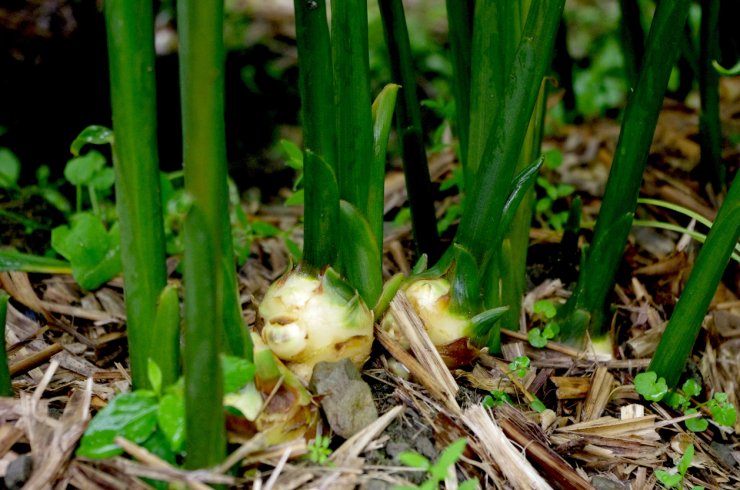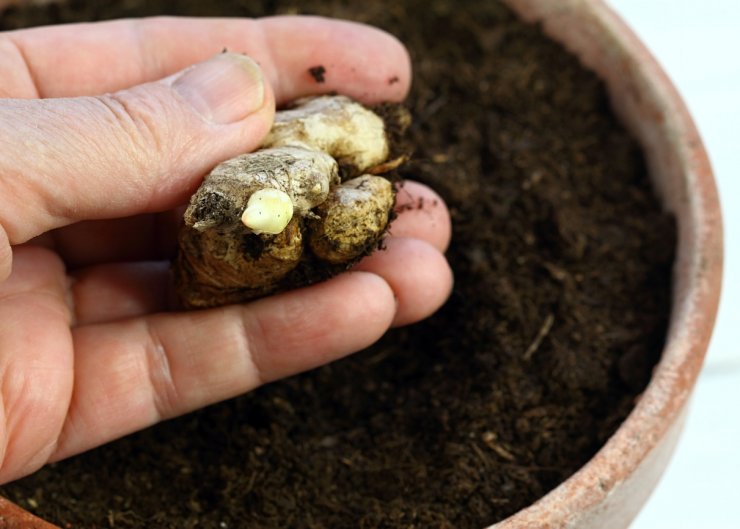
Ginger growing in a field.
When first planning where to grow your ginger, you should consider the type of land you can tend. If you have a large outside plot of land with the right soil and the right conditions for watering and draining, you might have the ideal situation for planting directly in the ground. But if your soil is not the right composition—or you plan to plant other crops that shouldn’t grow near ginger (tomatoes, peppers, eggplant)—you might want to consider planting in raised beds or in containers or pots. If you have a garden plot, and if you’ve ever planted tomatoes, peppers, or eggplant in that area, don’t plant your ginger there; you run the risk of the ginger developing bacterial wilt, a disease caused by a bacterium commonly found among those other plants.
If your garden bed is safe for ginger, then you can just start planting!
Converting part of your yard into a workable garden may be more effort than it’s worth, depending on what you want to grow, how much you want to grow, and how long you anticipate tending your garden. If you’re not quite ready for that commitment, or your land doesn’t have the type of composition that lends itself to planting directly in the ground, consider raised beds and/or containers for growing your garden.
Growing in Raised Beds

Ginger in a raised bed.
Setting up raised beds is a short-term time-intensive task, but oh so worth it. Raised beds provide a full crop of benefits: plants are easier to reach (your back will thank you!), and you have much more control over your growing environment. Regular gardening tasks, like watering, weeding, and harvesting are easier with raised beds. You also have the benefit of being able to contain and control the spread of your crops; think asparagus or mint. And raised beds are more accessible than a traditional garden plot. If you have friends or family with limited mobility, it’s easy to get a chair, walker, or wheelchair right up to the raised bed. Once you’ve made that initial investment in setting up the raised beds, subsequent years will be easier. You’ll just need to give the soil some annual TLC, and keep track of what you plant where so you don’t run into any crop rotation conflicts.
To create nicely contained raised beds for your ginger, enclose your raised beds with wooden sides at least 8 inches wide—this will help keep the bed together, be tall enough, and make irrigation easier, too. With raised beds, your garden is less likely to contain the seeds of weeds that often show up in garden soil. You’ll minimize the incidence of weeds overall, which will save you time and effort later. Weeding itself is much easier with raised beds, since you don’t have to bend down so far on the ground to remove weeds.
You don’t have to build your raised beds from scratch, although all the components for a DIY garden bed are easily available at your home improvement store. There are even hardware kits available, along with directions on the size and length of lumber to buy to set things up.
You can go from economy to deluxe when you set up raised beds. Some kits come with premium wood. Other raised bed systems are made of recycled plastic or corrugated metal. The type of system you choose depends on your budget and your garden esthetic.
Annual Tip: To optimize the soil in your raised beds, be sure to amend your soil with composting at least once a year—otherwise, your soil can become less productive for your plants.
Growing Ginger in Containers or Pots

Growing Ginger in a Pot.
If you don’t have the space for growing in open land or in raised beds—let’s say you live in an apartment with no land of your own for a garden, for example—you can grow ginger in containers or pots on your balcony, porch, patio, or deck.
One great advantage to container gardening is that you can move your plants around more easily to maximize their exposure to the sun.
Tip: If you have trouble moving pots around, because they’re too heavy or too bulky, try putting your pots on slightly raised rolling casters so you can more easily move them around your space.
Potted ginger is not uncommon—you just have to know the right way to do container gardening for ginger. Since ginger is a tropical plant, it likes heat and humidity. But you need to make sure that your containers have adequate drainage so your plants don’t get waterlogged. But you don’t want them to dry out, either, so they need regular attention. The other caveat about container gardening is that, containers can lose important soil nutrients throughout the season, so you might need to add some fertilizer.
With container gardening for ginger, you want a container that’s much wider than it is deep. Ginger spreads out, so you want to leave lots of room for those new rhizomes to develop. Ideally, you can grow ginger in a broad, shallow dish-like container, or long window box-sized container. Remember, these plants are going to grow to be about 4 feet tall, so while you could put them in a window box, they’ll wind up blocking your view. Choose a container that will give your plants lots of running room, and plan their placement for sun, shade, and ease of access (consider putting the container on wheels).
Ginger doesn’t need a real deep container, just a wide one. You’ll plant your rhizomes a couple inches down. Some gardeners recommend you make sure the nodes, or buds, are facing up; others say it doesn’t matter, since the plant will grow toward the light anyway. But don’t make things harder for your ginger; it has a long enough growing season as it is. You’ll plant your rhizomes flat, with the bud areas facing up.
What to do with your container soil at the end of the season: At the end of your ginger-growing season, the soil in your pots will be spent, which means starting over when you create next year’s garden. Dispose of the soil at the end of the season by dumping the soil somewhere else—in another part of your yard or a place where you won’t be growing plants again. Don’t compost this soil for gardening. And if you suspect it might have been carrying a soil-borne disease like bacterial wilt—throw it in an area when you don’t plan to do any gardening.
How do you grow your ginger—in open land, in raised beds, or in containers? Why do you prefer your method? Please tell us your tips and tricks for growing a delicious ginger crop.


 Previous
Previous

